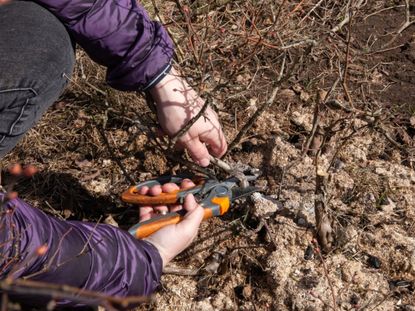How To Prune Blueberries The Right Way


There are two primary reasons to prune blueberry bushes regularly and strategically: to maintain healthy, thriving plants and to maximize fruit yield. Proper pruning of blueberries can make the difference between an average crop and a plentiful one.
Pruning is useful for keeping shrubs to a reasonable size and maintaining an attractive shape. But most importantly, regular, thoughtful pruning is vital for producing a hefty crop of blueberries.
When blueberry bushes are not pruned, they can become weak and leggy and produce smaller fruit. However, it’s important to note that if the pruning is too severe, the berries may grow larger but your crop will not be as prolific. The type and amount of blueberry plant pruning, however, may depend on the age, type and size of the bush. This article will help you understand and navigate the pruning process.
How to Prune Blueberry Bushes
The best fruit grows on newer, stronger blueberry canes that grow upright and higher in the bush. Pruning for health and to allow these productive canes to thrive will give you a better yield and higher-quality berries.
The primary objective in pruning blueberry bushes is to reinvigorate older canes and allow younger canes to develop. If you do it right, you will get years of plentiful harvests from healthy, thriving plants.
Pruning Young Blueberry Bushes
Pruning younger bushes, up to about two or maybe three years old, is all about promoting growth. In fact, you don’t even want the bush to produce fruit in these early years. A bush that fruits too early in its lifespan will be stunted later and produce less fruit.
During the first few years, remove flower buds before they can bloom. The flower buds (also known as fruit buds) can be distinguished from leaf buds by size and location: Fruit buds are on the terminal ends of the canes, about two to three inches (5.0 to 7.6 cm) down, and are larger and rounder.
Gardening tips, videos, info and more delivered right to your inbox!
Sign up for the Gardening Know How newsletter today and receive a free download of our most popular eBook "How to Grow Delicious Tomatoes."
In terms of pruning canes, focus on trimming to shape the plant and promote new growth. Cut back canes in a way that gives your plant the desired shape. Ideally, a productive plant should be narrow at the base, open in the center, and full and bushy at the top and on the sides.
Pruning in Seasons Two or Three Through Five
Once the bush has reached year two or three, you can stop removing the fruiting buds and begin to prune more strategically.
Remove crossed canes in the center of the bush to allow sunlight to penetrate to the interior. Remove any weak or damaged growth and canes that are too close to the ground.
Look for the larger, upright canes, and trim these back by about eight to ten inches (20 to 25 cm). Smaller, younger shoots should be trimmed back to about four or five inches (10 to 13 cm) below the top of the bush. This will stimulate lateral growth, which results in greater production.
Pruning Mature Blueberry Bushes
When your plant has reached maturity, around six years old, the oldest canes are no longer very productive. Identify these older canes and remove about a quarter of them. Doing this every year continually renews the bush, allows new canes to grow, and results in better fruit production.
Keep removing low-hanging canes and any that appear winter damaged or infested. You can also continue to remove some of the crossed branches in the center of the bush to allow for sunlight penetration.
Pruning an Overgrown Blueberry Bush
If you have a blueberry that has been neglected for years, pruning can potentially reinvigorate it. Start by removing any broken, damaged, or diseased canes. Prune out unproductive canes that have not produced any new growth. Remove several of the oldest canes and any that are criss-crossed or tangled. Keep in mind that the center of the bush should be open enough to allow air and sunlight. Again, trim off branches that are low to the ground.
An overgrown bush can and should be cut back pretty severely. This will stimulate new growth and give it a fresh start.
The Best Time for Blueberry Pruning
For the best results, prune blueberries once every year. The best time to do this is in late winter or early spring (January to early March), or at the end of the dormant season in your region when all chances of severe weather have passed.
Pruning in the fall season is risky because it promotes new shoots that will only die as the weather turns cold.
Trimming your blueberries thoughtfully and regularly can result in good fruit production for up to 50 years.

Nikki Tilley has been gardening for nearly three decades. The former Senior Editor and Archivist of Gardening Know How, Nikki has also authored six gardening books.
- Mary Ellen EllisWriter
-
 Clever Vertical Vegetable Garden Ideas For Small Spaces – 7 Ways To Save Space
Clever Vertical Vegetable Garden Ideas For Small Spaces – 7 Ways To Save SpaceShort on garden space? Learn some vegetable garden ideas for small spaces that are fun and easy.
By Mary Ellen Ellis
-
 26 Different Types Of Orchids – With Pictures & Information
26 Different Types Of Orchids – With Pictures & InformationDiscover stunning orchid types to grow in your home and garden – from easy beginner varieties to rare and exotic species that are the preserve of experts.
By Melanie Griffiths